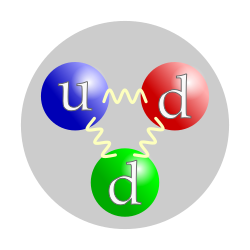ນິວຕຣອນ
ນິວຕຣອນ ແມ່ນ ອະນຸພາກ subatomic, ສັນຍາລັກ, ເຊິ່ງບໍ່ມີຄ່າໄຟຟ້າ, ແລະ ມະຫາຊົນ ຫຼາຍກ່ວາຂອງ proton ເລັກນ້ອຍ. ໂປຣຕອນ ແລະນິວຕຣອນປະກອບເປັນ ນິວເຄລຍ ຂອງ ອະຕອມ. ເນື່ອງຈາກ protons ແລະ neutrons ປະຕິບັດຕົວຄ້າຍຄືກັນພາຍໃນນິວເຄລຍ, ພວກມັນທັງສອງຖືກເອີ້ນວ່າ nucleon. ນິວຄລີອອນມີມະຫາຊົນປະມານໜຶ່ງໜ່ວຍມວນອະຕອມ, ຫຼື ດາລຕັນ (ສັນຍາລັກ: ດາ). ຄຸນສົມບັດແລະການພົວພັນຂອງເຂົາເຈົ້າແມ່ນອະທິບາຍໂດຍ ຟີຊິກ nuclear. Protons ແລະ ນິວຕຣອນ ບໍ່ແມ່ນ ອະນຸພາກປະຖົມ; ແຕ່ລະແມ່ນປະກອບດ້ວຍສາມ quarks.

| |
| ການຈັດປະເພດ | Baryon |
|---|---|
| ອົງປະກອບ | 1 up quark, 2 down quarks |
| ສະຖິຕິ | Fermionic |
| ຄອບຄົວ | Hadron |
| ການໂຕ້ຕອບ | ກາວິທັດ, ອ່ອນເພຍ, ແຂງແຮງ, ໄຟຟ້າ |
| ສັນຍາລັກ | n , n0 , N0 |
| Antiparticle | Antineutron |
| Theorized | Ernest Rutherford[1] (1920) |
| ຄົ້ນພົບ | James Chadwick[2] (1932) |
| Mass | 1.67492749804(95)×10−27 kg[3] 939.56542052(54) MeV/c2[3] 1.00866491588(49) Da[4] |
| Mean lifetime | 878.4(5) s (free)[5] |
| Electric charge | 0 e |
| Electric dipole moment | < 1.8×10−26 e⋅cm (experimental upper limit) |
| Electric polarizability | 1.16(15)×10−3 fm3 |
| Magnetic moment | −0.96623650(23)×10−26 J·T−1[4] −1.04187563(25)×10−3 μB[4] −1.91304273(45) μN[4] |
| Magnetic polarizability | 3.7(20)×10−4 fm3 |
| Spin | Page ແມ່ແບບ:Sfrac/styles.css has no content.1/2 <i>ħ</i> |
| Isospin | −Page ແມ່ແບບ:Sfrac/styles.css has no content.1/2 |
| Parity | +1 |
| Condensed | I(JP) = Page ແມ່ແບບ:Sfrac/styles.css has no content.1/2(Page ແມ່ແບບ:Sfrac/styles.css has no content.1/2+) |
ອ້າງອິງ
ດັດແກ້ທ້າວ ພຸດທະວົງ ຫລວອາມາດ.ວັນພຸດ 17/08/1980, ເບີໂທ+8562058647123
- ↑ Ernest Rutherford Archived 2011-08-03 at the Wayback Machine. Chemed.chem.purdue.edu. Retrieved on 2012-08-16.
- ↑ 1935 Nobel Prize in Physics Archived 2017-10-03 at the Wayback Machine. Nobelprize.org. Retrieved on 2012-08-16.
- ↑ 3.0 3.1 "2018 CODATA recommended values" https://physics.nist.gov/cuu/Constants/index.html Archived 2018-01-22 at the Wayback Machine
- ↑ 4.0 4.1 4.2 4.3 Mohr, P.J.; Taylor, B.N. and Newell, D.B. (2014), "The 2014 CODATA Recommended Values of the Fundamental Physical Constants" Archived 2013-10-09 at the Wayback Machine (Web Version 7.0). The database was developed by J. Baker, M. Douma, and S. Kotochigova. (2014). National Institute of Standards and Technology, Gaithersburg, Maryland 20899.
- ↑ Zyla, P. A. (2020). "n MEAN LIFE". PDG Live: 2020 Review of Particle Physics. Particle Data Group. Archived from the original on 17 January 2021. Retrieved 25 February 2021.
- ↑ Olive, K.A.; (Particle Data Group); et al. (2014). "Review of Particle Physics" (PDF). Chinese Physics C. 38 (9): 1–708. arXiv:1412.1408. Bibcode:2014ChPhC..38i0001O. doi:10.1088/1674-1137/38/9/090001. PMID 10020536. S2CID 118395784. Archived (PDF) from the original on 2020-06-01. Retrieved 2017-10-26.